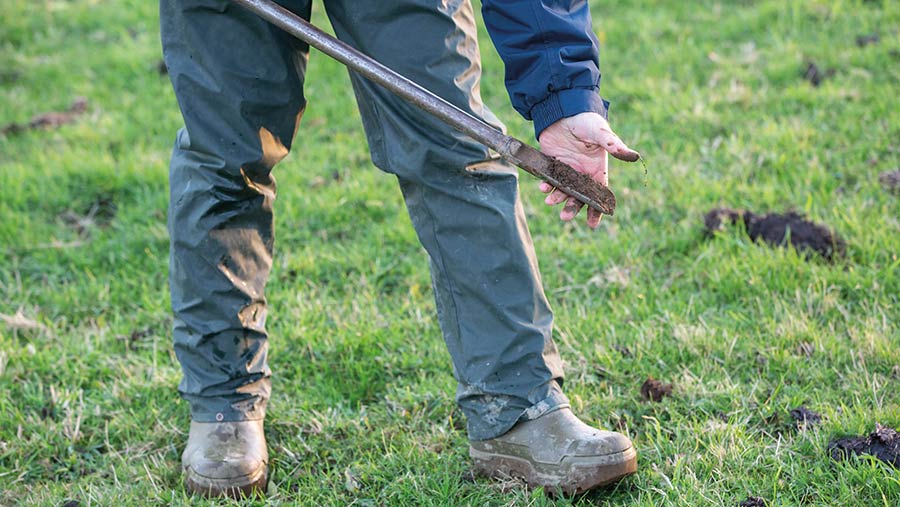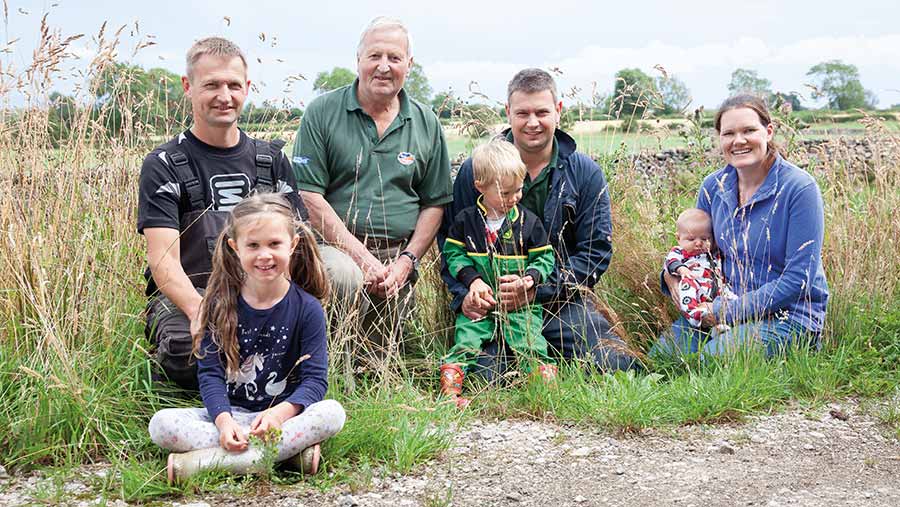Benefits of soil mapping for forage production
 © Carrs Billington
© Carrs Billington Soil-mapping grassland at a north Yorkshire dairy farm and using the data to vary lime applications within fields has captured cost savings on liming of £35/ha.
The Pratt family want to increase milk production from forage at Studdah Farm, near Leyburn, where they milk 145 high-yielding pedigree Holsteins.
The business is making 2,700 litres of the 10,700 litres a cow a year from grass silage and a wholecrop of barley, oats and peas.
The aim is to increase that to 3,500 litres to reduce purchased feed costs. Concentrate fed a cow a year is currently 3.2 tonnes.
To help reach this goal, the Pratts have mapped and zoned their fields with Rhiza precision technology.
See also: Guide to soil biology and how to protect it
Farm facts: Studdah Farm, Leyburn

© Carrs Billinton
- Medium loam soils
- High-yielding cows housed, with lows at grass
- 10,700 litres a cow a year
- 4.45% butterfat and 3.41% protein
- Milk sold to Wensleydale Creamery
Soil pH
A scanner was used to map out variations in pH and a quad-mounted hydraulic soil sampler analysed each zone.
All fields over 2.5ha (6 acres) were scanned, while whole field soil sampling was used for the smaller fields.
James Pratt, who farms with his parents, Alan and Edith, and brother, Richard, says this showed a big range in pH levels, from 5.8 to 7.3, between and within fields.
“We thought we had been doing a good job, sampling a few fields every year, so we were very surprised to see that variation,” Mr Pratt admits.
“It showed that we had been over-applying lime in some areas and under-applying it in others.”
Lime is fundamental to a plant’s ability to use nutrients. Reserves are depleted by rainfall and the application of fertiliser, and this increases the acidity of the soil as time goes by.
Targeted applications
At Studdah Farm, lime was previously spread at a uniform rate across the farm, but the Pratts now use the mapping system as a guide for applying nutrients only where they are needed.
In conjunction with Carrs Billington Agriculture, a main distributor for Rhiza, the collected data was used to create a lime application plan, with a mixture of variable-rate and whole-field applications.
If the lime had been applied at a flat rate of 5t/ha, the total input would have been 233t. At a variable rate, this was reduced to 180t.
With lime at £27/t, the Pratts made a total saving on liming of £1,431 in 2021, or £35/ha.
“We can target higher inputs on areas with a poor nutrient status and reduce inputs on those that don’t need it,” says Mr Pratt.
The cost of mapping can range between £35-£40/ha depending on factors such as field size – but the return on investment extends beyond the cost savings on lime, he points out.
“By using this system, we should get the whole farm growing grass at its optimum capability,” he says.
“We are in our first year of using it, so it is too early to tell how beneficial it will be, but our first-cut silage yields this year have been exceptional, and everywhere has been very productive.”
Nutrient management
He can manage the data through an app on his phone, identifying no-spread zones for nutrient management plans.
That Contour app can be used to identify multiple issues, from compaction and poor establishment to drainage damage and dock infestations.
The Pratts plan to use the data to manage slurry applications and to extend variable rate to fertiliser applications – they will either invest in a new fertiliser spinner with this capability or hire contractors to do the job.
“That will help us make bigger savings going forward,” says Mr Pratt.
The data will also help to inform decision making around reseeding and options in new environmental schemes, he adds.
“We can see which fields are less productive and perhaps enter those in the schemes,” he says.
The benefits of precision technology can be captured by all farms, regardless of size, according to Jim McRobert, of Carr’s Billington Agriculture.
Mapping is done on an escalating rate, therefore small farms can gain as much benefit if they contract in the equipment, he says.
The numbers
53t: Amount of lime saved by variable-rate spreading at Studdah Farm
1.5: Range in pH levels between fields sampled
£35-40: Cost of soil-mapping/ha
7.5cm: Recommended depth for sampling soil in grassland (Lancrop Laboratories)
Soil testing: When, where and why?
Soil testing is regarded as one of the best tools farmers have for planning profitable fertiliser applications.
Addressing chemical imbalances can make a big difference to production, says Hannah Shirt of Lancrop Laboratories.
Timing
Although there is no prescriptive time for when soil should be sampled, autumn is advisable, she says.
Silage fields should be tested after the final cut of the season, when the indices are at their lowest.
Consistency is the main consideration, Ms Shirt adds. “Always sample at the same time of the year and before fertiliser and slurry have been applied.”
When sampling, she advises farmers not to ignore measuring sulphur, pointing out that 95% of UK soils are deficient in the mineral.
“Grass does require more than N, P and K,” she says.
Depth
She recommends sampling at a depth of 7.5cm for grassland and 15cm for arable. Best practice is to sample a representative area in a w-shaped pattern, using clean tools that are free from rust.
Areas that are not representative of the field sampled should be avoided.
Indices
Soil pH should be 6-6.5 – by raising it from 5.5, about 30-40% more nitrogen is typically made available for plants, Ms Shirt adds.
“With reduced losses and increased nutrient use efficiency, this could deliver the equivalent fertiliser cost savings of up to a third, which in today’s market is significant.
“If farmers aren’t routinely conducting soil analysis, this insight can be very hard to realise, and this year particularly, farmers could be missing a trick.”
Index 2 is the ideal for potash and phosphate (P and K).
“In situations where levels are below target, species including Yorkshire Fog and creeping bents will dominate instead of better-quality grasses such as perennial ryegrass.
According to German scientist Justus von Liebig’s law of the minimum, a deficiency of any single nutrient is enough to limit yield.
Testing rules
In England, under the Farming Rules for Water, it is now compulsory to test for P, K, magnesium and pH.
